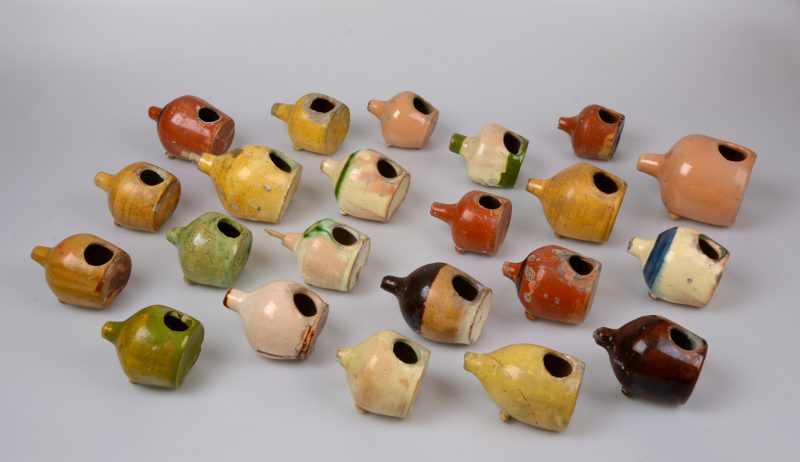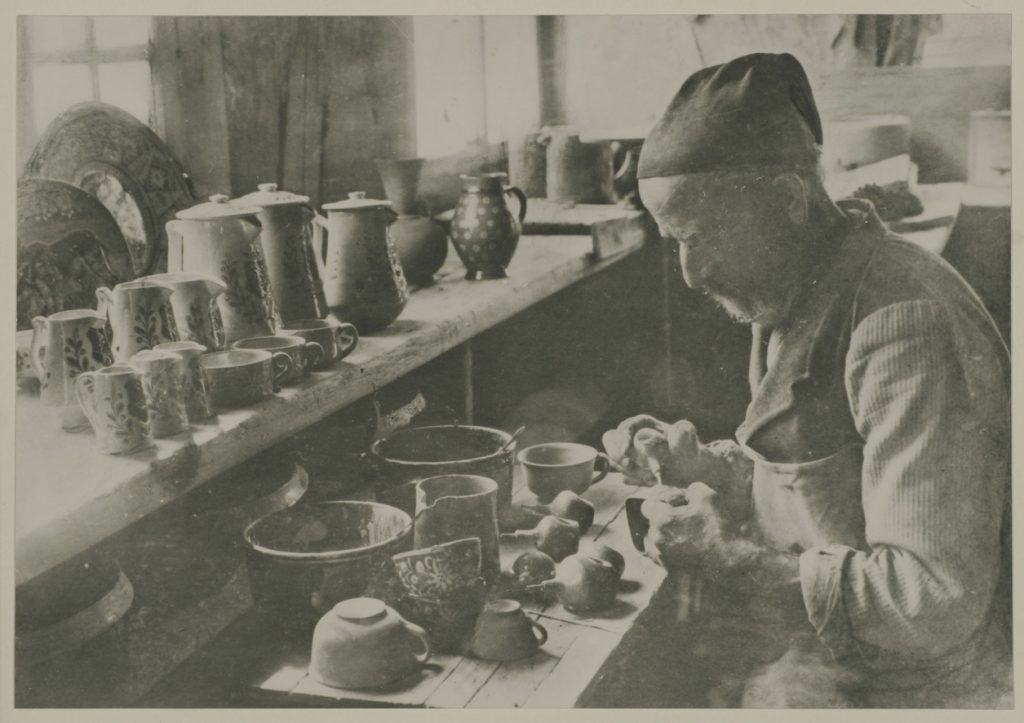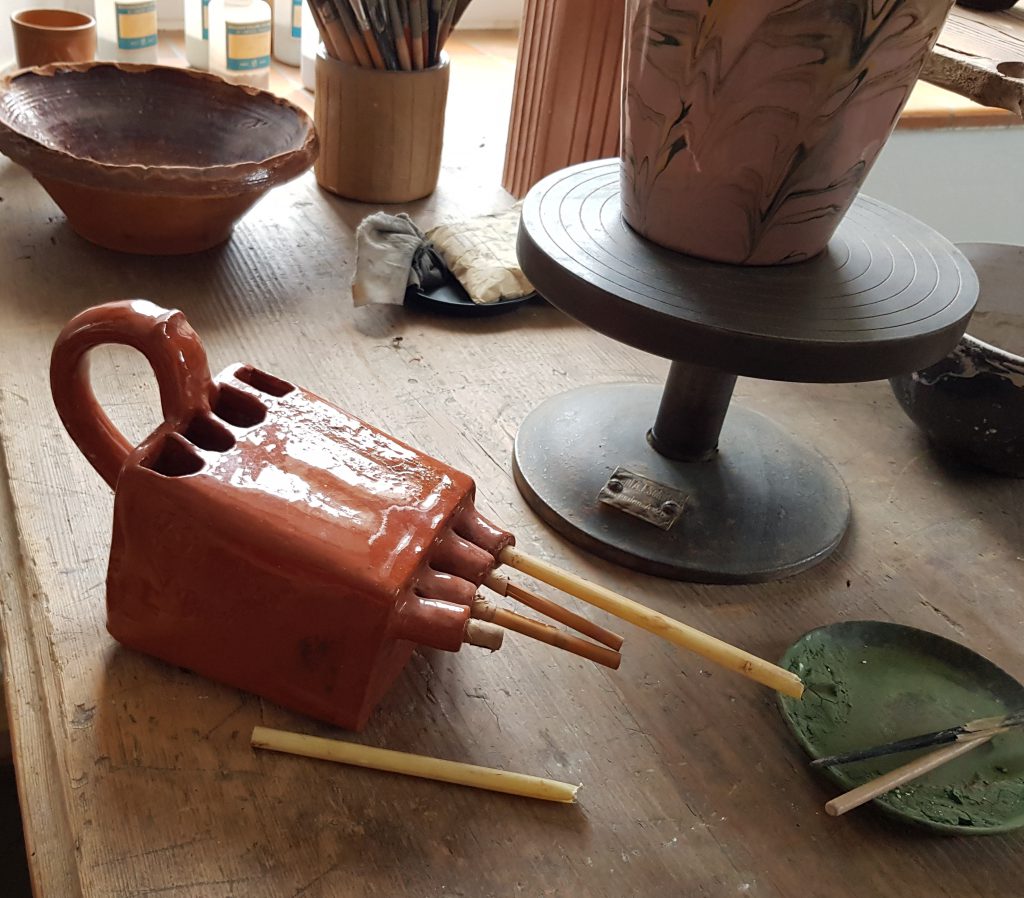
Slip-trailer from Horezu, Romania.
Andreas Heege, 2019
Slip-trailers or slip-cups were used to create slip-trailed decoration. Basic versions were made from cow horn with a quill inserted into the tip

Slip-trailers from the Röthlisberger pottery in Langnau, 20th century.
Ceramic slip-trailers were also commonly used. They had a hole on one side for pouring in the slip and a small opening at the front for inserting a quill. Some had indentations on the side to make them easier to hold. Depending on the thickness of the slip, potters could cover the fill hole with their thumb, which allowed them to regulate the flow of the slip. Slip-trailers in Switzerland often bore an incised date and/or the initials of the owner (pottery decorator or Pottery paintress) or the potter.

Heimberg potter 1917.
Archaeological finds of ceramic slip-trailers date back to the early days of slip-trailing in the second half of the 16th century. The oldest firmly dated objects known so far came from the Werra ware potteries in Enkhuizen, Netherlands (between 1602 and 1613, Ostkamp/Venhuis 2009, Fig. 41) and from Hannoversch-Münden, Germany (prior to 1612, Stephan 1992, Fig. 45).

Two-chambered slip-trailer from the Renaissance period at the Museum im Burghof Springe (Inv. 1993/1914, Leiber 2012, Cat. 52).
Slip-trailers with two or more compartments and nozzles were sometimes used to create multi-coloured or parallel trailed decorations, e.g. on the so-called Weser ware, a type of Renaissance-period pottery made in Germany between c. 1550/1570 and 1630/1640. Fragments of two such slip-trailers (found at Völksen) are housed at the Burghofmuseum in Springe, Germany.

Museum Bonfol, Canton of Jura, multi-chambered slip-trailer used to create marbled decoration.
Marbling or cat’s eye and earthworm decorations on multicoloured dipped wares and lathe-turned refined utilitarian earthenware with slip decoration from Staffordshire in England were created using multi-chambered slip-trailers or slip-cups (cf. Carpentier/Rickardt 2001, Figs 21-31). Ceramic slip-trailers with several compartments were also used at Bonfol, Canton of Jura or in the or in the Savoy region of France (Buttin/Pachoud-Chevrier 2007, 56) to create multi-coloured marbled decoration.
So-called blowing bottles used in the Staffordshire pottery industry were technological advancements on slip-trailers (cf. Carpentier/Rickardt 2001, Fig. 13). Today, very fine slip-trailed decorations are made using bulb trailers made of rubber with glass, metal or plastic nozzles.
Translation Sandy Haemmerle
German: Malhörnchen
French: barolet (alternative term in the Alsace “cochonnet”)
References:
Buttin/Pachoud-Chevrier 2007
Anne Buttin/Michèle Pachoud-Chevrier, La Poterie domestique en Savoie, Annecy 2007.
Carpentier/Rickard 2001
Donald Carpentier/Jonathan Rickard, Slip Decoration in the Age of Industrialization, in: Ceramics in America, 2001, 115-134.
Leiber 2012
Christian Leiber, Aus dem Pottland in die Welt. Eine historische Töpferregion zwischen Weser und Leine, Holzminden 2012, 215 Kat. 52.
Ostkamp/Venhuis 2009
Sebastiaan Ostkamp/Sjek Venhuis, “tot soulagemente van de schamele gemeente” – Het Werra-aardewerk uit de werkplaats van Dierck Claaesz Spiegel in Enkhuizen opnieuw bekeken (1602-1613), in: Hemmy Clevis/Hans van Gangelen, Werra Keramiek uit Enkhuizen opnieuw bekeken – Studies aangeboden aan Jan Thijssen, Zwolle 2009, 11-96.
Röhrich/Meinel 1975
Lutz Röhrich/Gertraud Meinel, Töpferei im Elsass dargestellt am Beispiel von zwei Familienbetrieben in Oberbetschdorf und Soufflenheim (Veröffentlichung des Alemannischen Instituts Freiburg i. Br. 36), Bühl 1975, bes. 69-75.
Stephan 1992
Hans-Georg Stephan, Keramik der Renaissance im Oberweserraum und an der unteren Werra (Zeitschrift für Archäologie des Mittelalters, Beiheft 7), Köln 1992, Abb. 45.

